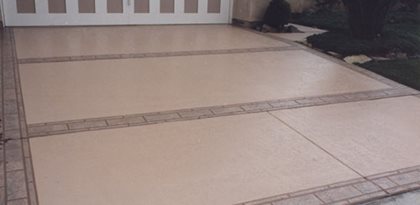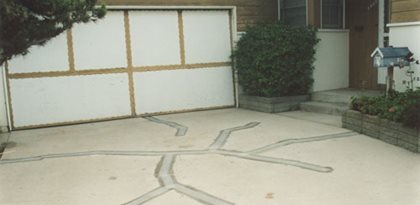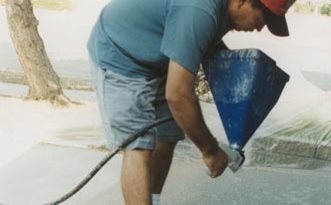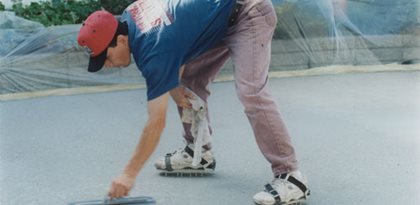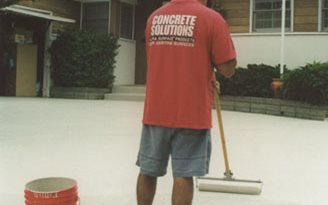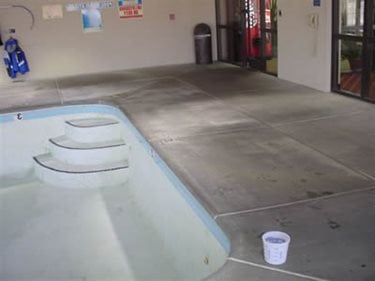- Concrete Resurfacing Home
- Raising Sunken Concrete by Slabjacking
- Restore Concrete: Resurfacing Outdoor Driveways, Patios, Pool Decks, Sidewalks and Walkways
- Resurfacing Interior Floors: Cover Concrete with Decorative Concrete Overlays
- Driveway Resurfacing
- Decorative Options for Concrete Overlays
- Adding Color to Overlays
- Stamped Concrete Patterns and Designs
- Outrageous Concrete Overlay Projects
- Concrete Floor Coverings: Creative Ways to Cover Concrete
- Other Ways to Add Pattern and Color to Existing Concrete
- Staining Concrete to Improve the Appearance
- Applying Decorative Stencils to Existing Concrete
- Sawcutting Patterns in Existing Concrete
- Concrete Engraving
- Garage Floor Coatings: add Color, Hide Imperfections
- Related Information
- Five Ideas for Remodeling with Concrete
Decorative Concrete Resurfacing Options & Refinishing Ideas
How to resurface concrete that is old, ugly and in need of refinishingConcrete resurfacing is a way to refinish old concrete to look new again. A concrete coating is applied over the existing surface, offering a variety of color, texture and pattern options. This type of decorative concrete restoration can be done on driveways, patios, pool decks and even indoor floors.
Find contractors: Concrete resurfacing near me
ON THIS PAGE
Use this table of contents to jump ahead:
- Replace or resurface?
- Concrete resurfacing options
- Does concrete resurfacing last?
- Decorative resurfacing ideas
- Preparing concrete for resurfacing
- How to resurface concrete
- Before and after pictures
- Other ways to make existing concrete better
REPLACE OR RESURFACE?
Conventional wisdom holds that old concrete must be torn out and replaced to improve the look. But there are many repair options available that will save you money, conserve resources, and eliminate disposal problems.
Resurfacing old concrete is perfect for:
- Fixing cracks
- Addressing discoloration
- Hiding surface imperfections
- Updating outdated finishes
- Covering unsightly concrete
Completely resurfacing concrete with an overlay is one way to upgrade the look, and you can choose from a wide variety of color and pattern options. If your concrete is in good condition but just needs a facelift, you can also stain, stencil or engrave it to improve the appearance. Here, we tell you all you need to know about restoring existing concrete, including procedures, application techniques, and decorative options.
Concrete Resurfacing - Skimcoat Overlay Application
Time: 07:31
What is an acceptable surface to be resurfaced?
Small plastics shrinkage cracks or crazing cracks can be covered by the polymer prime coat and base coat of the resurfacing material.
Larger cracks must be repaired. See Is it worth fixing
In any case, the underlying concrete for a resurfacing project must be sound. It is not feasible to resurface concrete that is heaving, has severe cracks, or is damaged due to freeze/ thaw damage. Resurfacing will not solve underlying soil problems.
Read about types of repairs that can be done to concrete: Basics of concrete repair and troubleshooting
CONCRETE RESURFACING OPTIONS
When resurfacing concrete, you can get any look you want. Here are some popular options:
- Stamped concrete overlays
- River rock or pebble coating
- Cool deck finishes
- Epoxy coatings with color flakes or metallic pigments (garages)
- Spray down texture coatings
- Broom finish applications
- Integral or topically applied color
- Stenciled patterns or hand carved designs
DOES CONCRETE RESURFACING LAST?
If you use a high-quality resurfacing product and have it professionally installed, you can expect it to last 10 years or more. Some contractors have even seen resurfacing last 25 years! But if you go with a DIY resurfacing kit from a big box store, they don't last as long.
Proper cleaning, maintenance and protection go a long ways to making your new surface long-lasting. Make sure to have your concrete sealed, and then reseal as needed.
DECORATIVE CONCRETE RESURFACING IDEAS
There are a variety of decorative overlay options to cover concrete driveways, pool decks, patios, parking areas, and almost any other concrete surface.
Whether you'd like to restore your outdoor concrete or bring new life to the inside of your home with a decorative floor overlay, start by looking at photos to see what you like.
Popular resurfacing projects:
A wide variety of colors are available and flagstone, fan, brick, random stone, and other patterns can be chosen.
Find more info on: Stamping Concrete or Coloring Concrete
Borders are often resurfaced with a different pattern than the interior of the slab surface- providing bold highlights.
PREPARING CONCRETE FOR RESURFACING
The most critical factor when covering concrete with an overlay is to prepare the substrate properly. Overlays are designed to adhere tenaciously to existing concrete. But they must have a clean, solid base to grasp on to. That's why overlooking the prep work, or not doing the job thoroughly, is the most common cause of overlay delamination and failure.
The basic steps in surface preparation include:
- Cleaning the concrete to remove all substances that could inhibit the ability of the overlay to bond, such as dirt, oil and grease. It's also necessary to strip away any coatings, sealers or paints that may have been applied to the concrete.
- Removing any unsound concrete, such as minor spalling, scaling or delamination, down to solid concrete.
- Filling active cracks so they don't mirror through to the overlay. Typically any cracks equal to or wider than the width of a credit card will require repair. (See steps in repairing cracks for a concrete resurfacing job.)
- Profiling, or roughening, the concrete surface to improve the "grip" of the overlay.
Using a machine that mechanically abrades the concrete, such as a grinder or shotblaster, is one of the most effective ways to prepare concrete substrates for resurfacing. This equipment not only removes most contaminants and unsound concrete, it will also leave behind a roughened surface profile. (Read more about proper surface preparation procedures and equipment.)
Clearly, this is a simple overview. The procedures will vary depending on the condition and age of the concrete and the surface preparation guidelines recommended by the overlay manufacturer. This is a job best left to a professional who will be able to assess the condition of your existing concrete and determine the scope of work required to ensure good overlay bonding and performance.
HOW TO RESURFACE CONCRETE - STEP BY STEP GUIDE
Here's a pictorial overview of preparing concrete for resurfacing with Ultra Surface Polymer:
8 Reasons to Rethink a DIY Concrete Resurfacing Project
CONCRETE RESURFACING BEFORE & AFTER PICTURES
Check out these examples of restored and resurfaced concrete work:
Hotel Pool Deck Gets a New Surface
Restoring this indoor pool deck only took Travis Winters, the owner of Nebraska Concrete Coatings, five days. The hotel manager wanted to improve the appearance of the pool area to increase guest satisfaction and reduce the amount of maintenance required to keep it looking good. The existing deck was stained and rough on bare feet. The concrete was ground down, acid washed, neutralized and power washed. Then cracks were repaired and a skim coat applied. A diamond pattern and brick border were taped off and colored to create a decorative look.
Learn more about this project: Hotel Pool Deck Resurfacing
Concrete Overlay Transforms an Ugly Entryway
There’s nothing worse than an entryway that is unattractive and unsafe. For this home, Barry Fisher of Unique Concrete knew exactly how to solve the problem. After the tiles were removed and the underlying concrete prepared, a 1 ½-inch layer of unbonded reinforced concrete was applied. The fresh concrete was then stamped and hand chiseled to recreate the look of natural stone and tile. There are no visible control joints because the concrete is heavily reinforced with wire mesh.
Get the full story: Concrete Overlay Transforms an Ugly Entryway
OTHER WAYS TO MAKE EXISTING CONCRETE BETTER
Resurfacing isn't the only option for transforming existing concrete. Below is a list of decorative procedures and application techniques that you should also consider.











